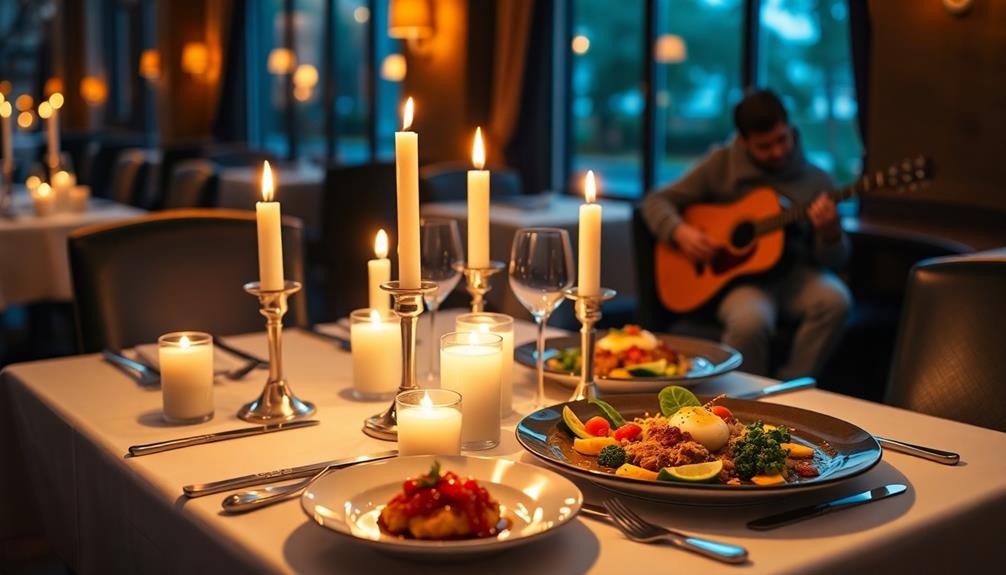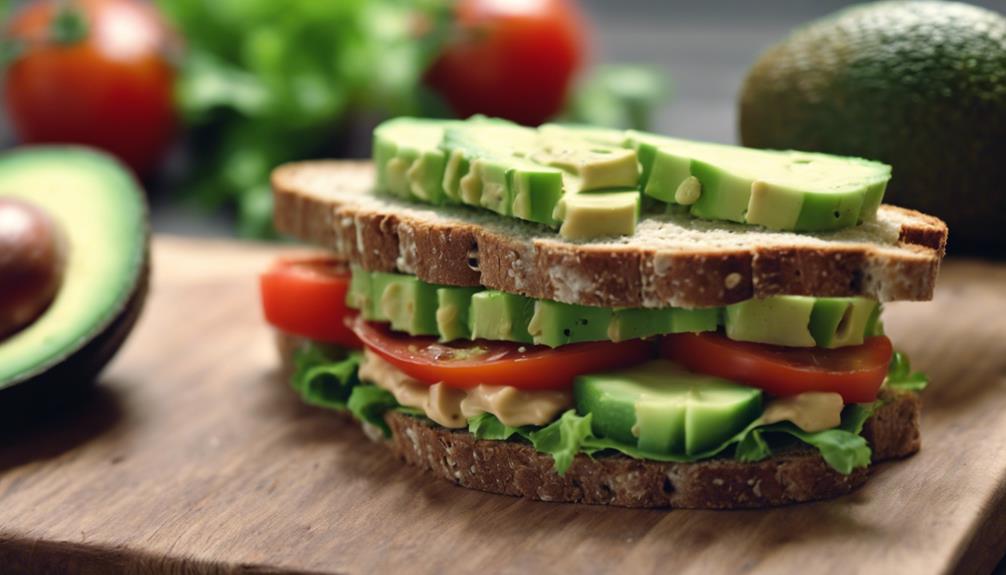Music plays a significant role in shaping your dining experience. It affects your mood, enhances emotional responses, and influences how you perceive flavors. For instance, upbeat tunes can make meals more exciting, while slower melodies encourage you to savor your food. The right music even impacts your dining pace; faster tunes might speed up your meal, while soothing sounds can lead to longer, more enjoyable visits. Furthermore, aligning music with the restaurant's brand can elevate your satisfaction. Discovering how these elements interact can enrich your future outings and enhance your dining adventure.
Key Takeaways
- Upbeat music boosts liveliness and cheerfulness, enhancing the overall dining experience and customer satisfaction.
- Slower music creates a relaxed atmosphere, encouraging diners to savor their meals and increasing enjoyment.
- Music genre influences taste perception, making ethnic cuisines feel more authentic and enhancing diners' enjoyment.
- Brand-aligned music can increase restaurant revenues by improving emotional responses and customer loyalty.
- The tempo of background music affects dining pace, with fast music promoting quicker meal completion and slow music encouraging longer stays.
Mood Enhancement Through Music
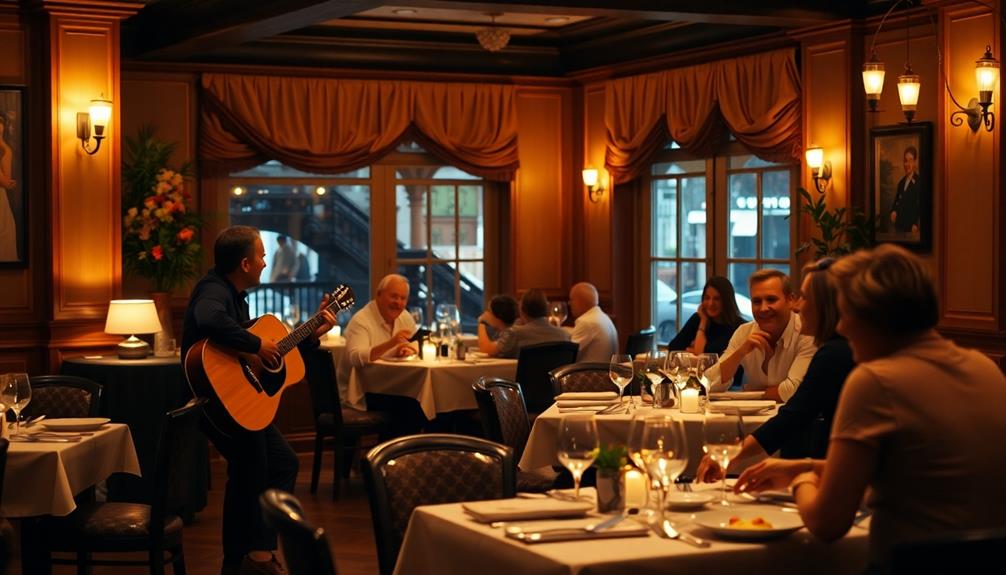
When you walk into a restaurant, the music playing in the background can instantly shape your mood. Upbeat tunes often boost liveliness and cheerfulness, enhancing your overall dining experience. For instance, enjoying a dish like Nettle and Potato Soup while listening to lively music can elevate the enjoyment of fresh, seasonal ingredients.
You mightn't realize it, but background music considerably influences your emotional responses. For instance, studies show that classical music can elevate your enjoyment levels, leading to more positive feelings during your meal.
The tempo of the music also plays an important role. If the background music is slower, it creates a relaxed atmosphere, which can increase your satisfaction and even encourage you to linger longer over your meal. Think about the last time you felt nostalgic while listening to familiar tunes; that connection can enhance your dining experience even further.
Choosing appropriate music that aligns with the restaurant's brand identity is essential. When the music resonates with the restaurant's vibe, your emotional responses tend to be higher, resulting in greater dining satisfaction.
Music's Effect on Taste Perception
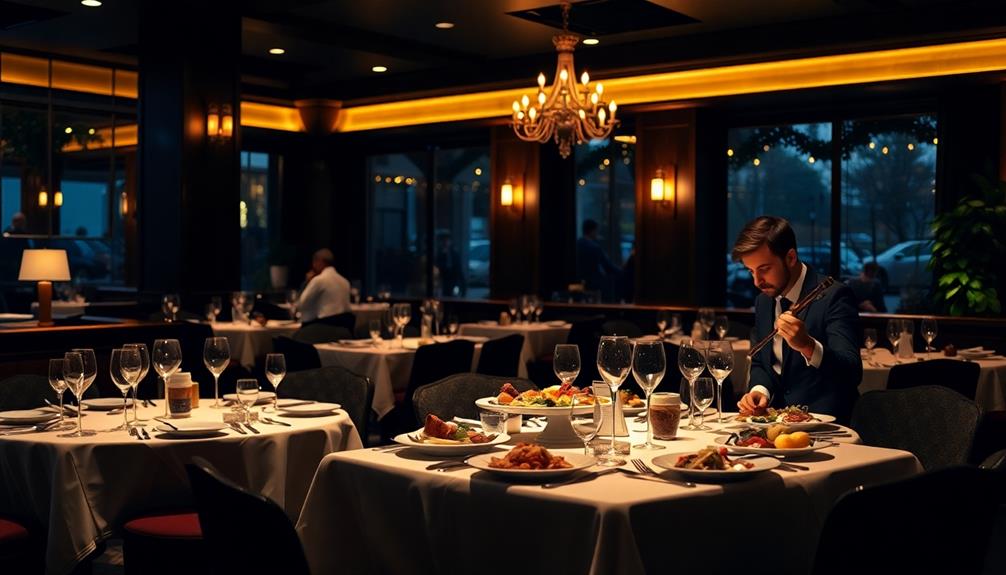
The music you hear while dining can greatly alter how you perceive flavors. Research shows that loud, fast-paced music can make your meal seem spicier, while soft, slow tunes often create a sense of tenderness in dishes. This means the type of background music you encounter can considerably impact your overall dining experience.
When you listen to adventurous or culturally relevant music, such as the sounds accompanying traditional Ethiopian dishes like Tella and Tej, you might feel more inclined to try new dishes, expanding your palate and enhancing your enjoyment of the meal.
Additionally, the genre of music plays an essential role in shaping your perceptions of food quality. Ethnic cuisines, for instance, can seem more authentic and appealing when paired with their corresponding music.
Furthermore, the right soundtrack can lead to indulgence, as studies indicate that specific music influences dessert orders, making you more likely to indulge your sweet tooth.
Dining Pace and Music Tempo
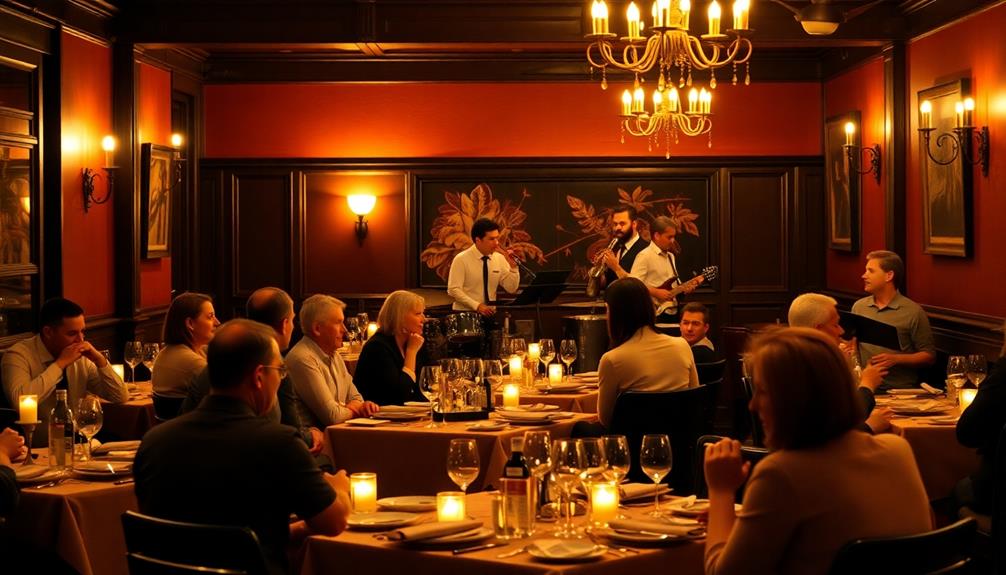
Have you noticed how the tempo of music can change the way you eat? When upbeat tracks play, you might find yourself finishing your meal faster, while slower melodies encourage you to take your time and enjoy each bite.
This connection is particularly evident when dining on rich dishes like Red-Braised Pork Belly, which benefit from a leisurely pace to fully savor the flavors.
Understanding this connection can help restaurants manage the flow of dining and enhance your overall experience.
Tempo's Effect on Eating
Music can set the mood for your dining experience, and its tempo plays an essential role in how quickly you eat. Fast-paced music can have you scarfing down your meal, while slow music encourages you to savor every bite. This is especially true in settings featuring comfort foods like loaded baked potatoes, where the enjoyment of flavors can be enhanced by a more relaxed pace.
Here's how tempo influences your dining pace:
- Quick Turnover: Fast music can lead to quicker meal completion, increasing the number of diners a restaurant can serve.
- Leisurely Enjoyment: Slow music invites you to linger, potentially boosting your total bill by up to 50%.
- Enhanced Satisfaction: When you savor your food to slow music, you're likely to feel more satisfied with your meal.
- Perceived Wait Times: Faster music can make waiting for food feel shorter, improving your overall experience.
The tempo of background music greatly impacts not just how fast you eat but also your overall dining experience.
By strategically using slow music during quieter hours, restaurants enhance your enjoyment and encourage you to stay longer.
Managing Flow With Music
Creating the right atmosphere in a restaurant hinges on the careful management of music tempo. Fast-paced music can speed up your dining experience, prompting you to eat quicker, while slower tunes encourage you to linger.
For instance, when enjoying a delicious dish like Kedjenou, the accompanying music can enhance the overall experience. Research shows that when upbeat music plays, diners often complete their meals faster, which can reduce dining time. On the flip side, slow music can extend your stay, potentially increasing your total bill by up to 50%.
Synchronizing the pace of service with the music tempo is key to enhancing customer flow. When your eating pace matches the rhythm, you're likely to feel more satisfied. Additionally, a lively ambient tempo can make wait times seem shorter, improving overall enjoyment during your meal.
Restaurants often use these insights strategically during peak hours to manage customer flow efficiently. By adjusting the music tempo, they create an atmosphere that balances fast service with a pleasant dining experience.
Brand Identity and Sound
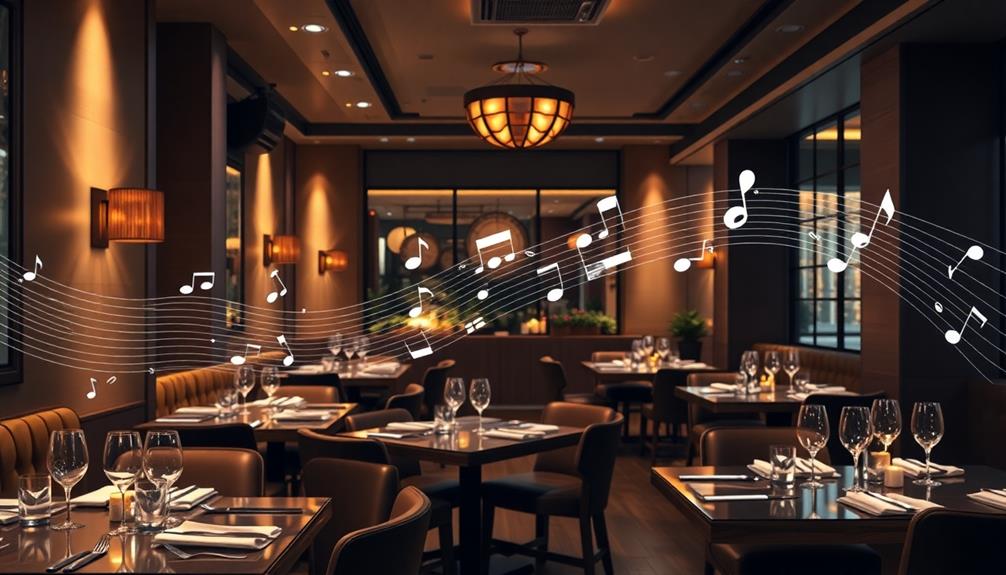
When you choose music for your restaurant, you're not just filling silence; you're shaping your brand identity.
The right genre can resonate emotionally with your audience, enhancing their overall experience and perception of your establishment.
Incorporating elements of Brazilian cuisine into your dining atmosphere can create a unique ambiance that reflects cultural richness.
Music's Role in Branding
While it might seem like a subtle detail, the right soundtrack can dramatically shape a restaurant's brand identity and customer experience. When the music aligns with your brand values, it not only enhances the atmosphere but also influences consumer choices.
For instance, a spooky soundtrack could elevate the dining experience during Halloween-themed events, complementing seasonal dishes like Graveyard Taco Dip. In fact, studies reveal that when you prioritize brand congruence in your music selection, it can improve your revenue considerably.
Here are four powerful ways music impacts your brand:
- Increased Revenue: Brand-fit music can boost revenues by 9.1% compared to non-aligned tracks.
- Enhanced Loyalty: Emotional responses heighten when music aligns with your brand, fostering customer satisfaction and loyalty.
- Higher Dessert Sales: Curated soundtracks can lead to over a 15% increase in dessert sales.
- Longer Stays: A carefully integrated sound strategy encourages guests to linger longer and spend more.
Emotional Resonance With Audiences
Music doesn't just enhance the dining atmosphere; it also forges a deep emotional connection with customers. When the music aligns with your restaurant's brand identity, it can greatly influence emotional responses, enhancing customer satisfaction and engagement. Studies reveal that congruent music increases revenues by 9.1%, demonstrating how essential sound selection is for shaping perceptions in your dining environment.
By strategically choosing music that reflects your brand's values, you create a unique ambience that resonates with your audience. This emotional resonance fosters loyalty, making customers more likely to return. In fact, research shows that dessert sales can surge by over 15% when the music aligns with the food category, showcasing the power of sound in elevating specific dining experiences.
Here's a quick overview of how music impacts dining:
| Aspect | Emotional Response | Financial Impact |
|---|---|---|
| Brand Alignment | Heightened Engagement | +9.1% Revenue Increase |
| Congruent Music | Enhanced Satisfaction | +15% Dessert Sales Boost |
| Unique Atmosphere | Stronger Customer Loyalty | Improved Brand Identity |
Embrace the power of music to transform your dining experience.
Genre Alignment and Perception
A well-chosen music genre can greatly shape your restaurant's brand identity and influence customer perception. When you align the genre of music with your restaurant's theme, it enhances the dining experience and can even increase your revenue by 9.1%.
For example, a restaurant featuring traditional Japanese cuisine could incorporate music that reflects this rich culture, much like how Dorayaki (Red Bean Pancake) represents a beloved aspect of Japanese confectionery.
Here are some ways genre alignment impacts perceptions:
- Cultural Connection: Ethnic cuisine paired with culturally relevant music reinforces brand identity and elevates food quality perceptions.
- Emotional Response: The right music evokes emotions, making diners feel more satisfied and engaged.
- Memorability: Curating a unique soundtrack helps your restaurant stand out, leading to higher customer retention rates.
- Premium Choices: For instance, classical music often prompts diners to opt for higher-priced menu items, enhancing their overall experience.
Customer Demographics and Music Preferences
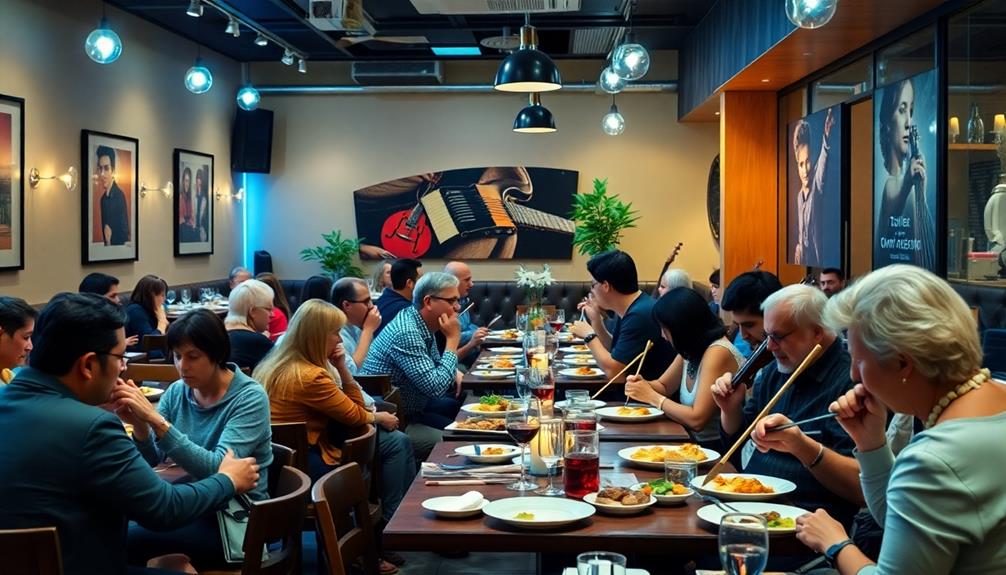
Understanding customer demographics plays an essential role in shaping music preferences in dining settings. As you consider the diverse clientele, you'll notice that younger audiences, typically aged 20-30, gravitate towards contemporary pop or hip-hop, while enjoying a meal of classic Italian dishes like agnolotti or pasta with tomato sauce.
In contrast, older patrons often lean towards classic rock or jazz. This distinction is crucial for enhancing their dining experience.
In a study of 393 participants, classical music emerged as a favorite, achieving a mean score of 5.15. Remarkably, BL-classical music was rated highly suitable for restaurant environments, with an impressive average of 5.45. This emphasizes how aligning music genres with customer demographics can greatly impact satisfaction.
Research shows that music preferences are closely tied to the overall dining experience. For instance, when you play music that resonates with your audience's age and style, you're likely to boost their enjoyment.
Staff Productivity and Atmosphere
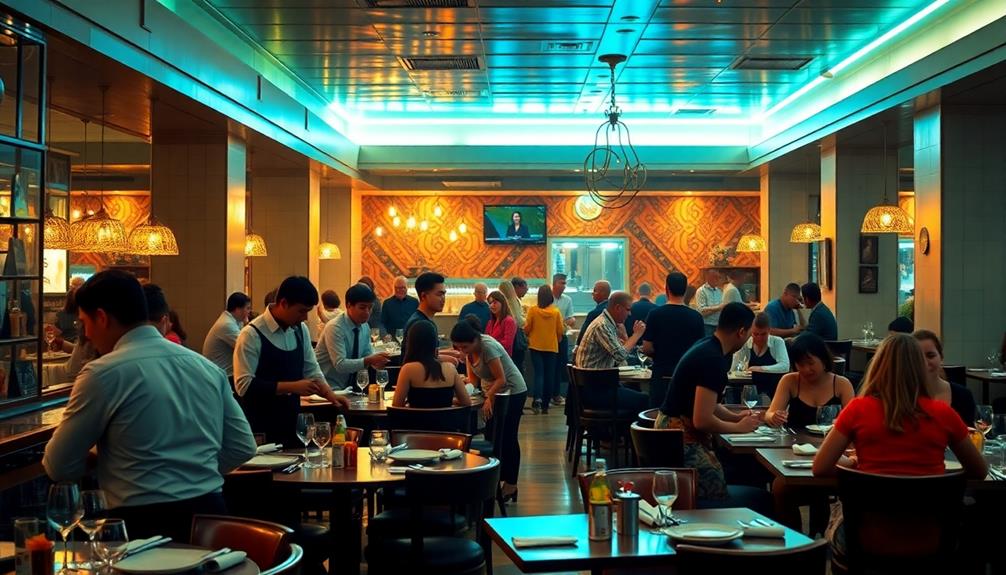
When you play upbeat music in your restaurant, you'll notice a boost in your staff's energy and morale.
This lively atmosphere not only keeps your team engaged but also leads to more efficient service.
For instance, when the kitchen staff is preparing popular dishes like Squash Casserole, the rhythm can enhance their workflow and creativity.
Ultimately, the right tunes can transform the dining experience for both your staff and customers alike.
Music's Effect on Energy
Music plays an essential role in shaping the energy levels of restaurant staff, directly influencing productivity and the overall atmosphere. When you choose the right tunes, you can create an invigorating experience that boosts morale and enhances service quality.
Here's how music impacts energy in your restaurant:
- Upbeat Tracks: Fast-paced music can elevate staff productivity, making them work quicker and serve customers efficiently.
- Curated Playlists: Carefully selected playlists lead to a more enjoyable dining atmosphere, making both staff and patrons feel more engaged.
- Volume Matters: Studies show that the right music volume correlates with increased food consumption rates, directly impacting your sales.
- Live Music Events: Hosting live performances can attract larger crowds, creating a vibrant atmosphere that energizes your team and enhances the overall dining experience.
Enhancing Team Morale
A well-chosen soundtrack can greatly uplift team morale in your restaurant, fostering a positive and productive work environment. When you curate an upbeat music selection, you create an atmosphere that enhances staff performance.
Research shows that energetic tunes can elevate mood and energy levels, making it easier for your team to stay motivated during busy shifts. In a lively dining space, employees are more likely to engage positively with customers, leading to improved service quality.
This connection between music and morale isn't just anecdotal; case studies indicate that restaurants with thoughtful playlists see increased sales and customer satisfaction. By choosing the right tracks, you can transform a mundane workday into an enjoyable experience for your staff, which, in turn, boosts their interaction with diners.
Moreover, live music events can amplify this effect, attracting larger crowds and invigorating your team's enthusiasm. A vibrant atmosphere not only enhances the dining experience but also keeps your staff motivated and engaged.
Emotional Responses to Background Music
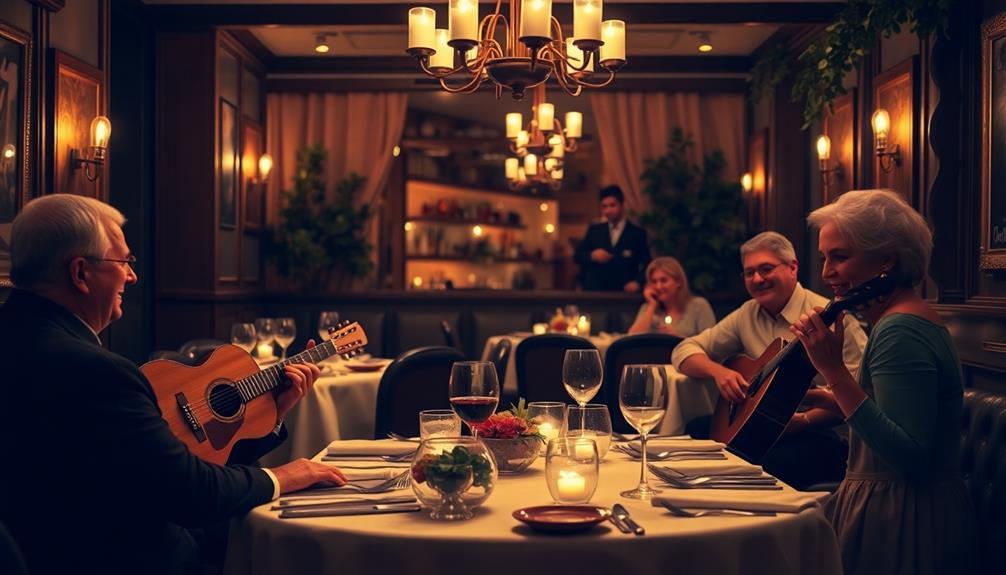
Dining experiences are often transformed by the subtle influence of background music, which plays an essential role in shaping emotional responses. When you sit down to enjoy a meal, the music playing around you can evoke a range of feelings, ultimately enhancing your overall experience. Soft, soothing melodies might amplify feelings of relaxation, while upbeat tunes could energize the atmosphere, encouraging lively conversation. This interplay between sound and emotion can also complement the psychological benefits of comfort eating, as the right music helps create an environment where diners feel more at ease and content. Together, the harmony of flavors and sounds turns a simple meal into a multi-sensory experience.
Research shows that classical music, in particular, has a significant positive impact on emotions during dining. Here are four key emotional responses you might experience:
- Increased Pleasure: Classical music has been linked to higher pleasure levels, making your meal more enjoyable.
- Heightened Arousal: Engaging music can elevate your excitement and anticipation, enhancing the dining atmosphere.
- Improved Appetite: The right background music can stimulate your appetite, encouraging you to savor every bite.
- Boosted Satisfaction: When the music aligns with your dining experience, it fosters a sense of contentment, making you more likely to return.
With studies showing that classical music achieved the highest emotional response scores, it's clear that choosing the right music can elevate your dining experience, leading to memorable moments and increased consumer engagement.
Research Methodology Overview

The research methodology employed in this study was designed to thoroughly assess the impact of music on dining experiences. A sample size of 393 participants was gathered using purposive and snowball sampling methods from March to June 2020. The research team divided subjects into four groups, each experiencing controlled music conditions featuring two classical pieces arranged in classical and jazz genres.
To measure the effects, data collection utilized a background music preference scale, emotion evaluation scale, and behavioral response scale. The study guaranteed high sampling adequacy (KMO = 0.931), with statistical analysis performed using SPSS 25.0. A factorial experimental design combined survey methods to capture how music in restaurants influences emotions and behaviors.
Here's a summary of the research methods:
| Method | Description |
|---|---|
| Sample Size | 393 participants |
| Sampling Method | Purposive and snowball sampling |
| Music Conditions | Classical and jazz genres |
| Data Collection Tools | Preference scale, emotion evaluation, behavioral scale |
| Statistical Analysis | One-way ANOVA and multiple regression |
The results highlighted significant differences in emotional and behavioral responses across the various music conditions tested.
Case Studies on Music Impact
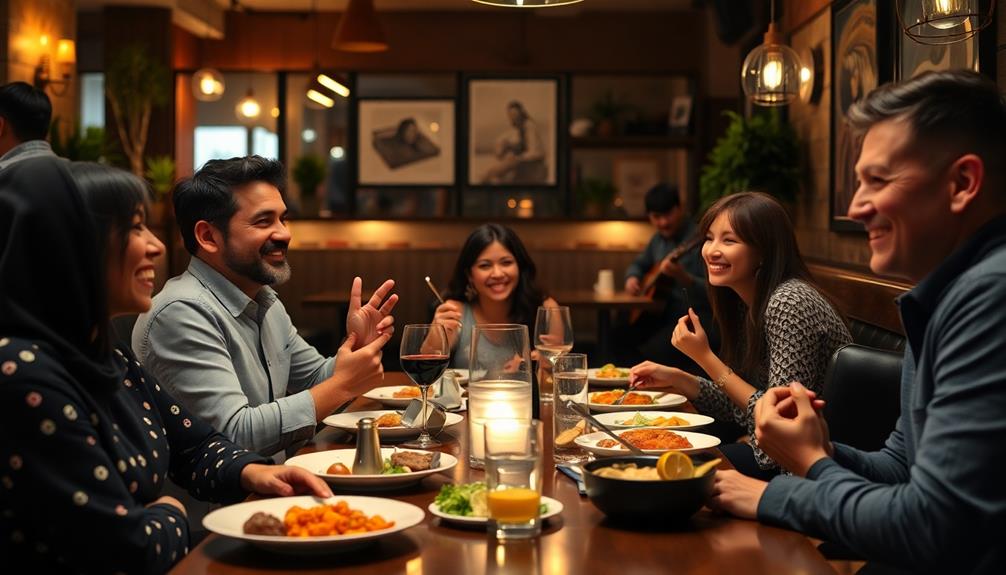
Music's influence on dining experiences is evident in various case studies that showcase its impact on consumer behavior and emotional responses. For instance, a study in 16 chain restaurants revealed that brand-fit music led to a 4.8% sales increase for one brand, while non-aligned music caused a 4.3% decline. This highlights how essential music selection is in dining environments.
Here are some key findings that emphasize music's impact on consumers:
- Dessert sales spiked over 15% with brand-fit music, showing its power to influence spending.
- In high-end Chinese restaurants, classical music improved emotional enjoyment, leading to higher satisfaction scores.
- An analysis of 1.8 million transactions found congruent music enhanced customer emotions and extended stay duration.
- Slow-tempo music combined with angular shapes markedly improved the dining experience for solo diners.
These case studies illustrate that the right music selection can elevate your dining experience, boost sales, and create a more enjoyable atmosphere.
Future Trends in Restaurant Music
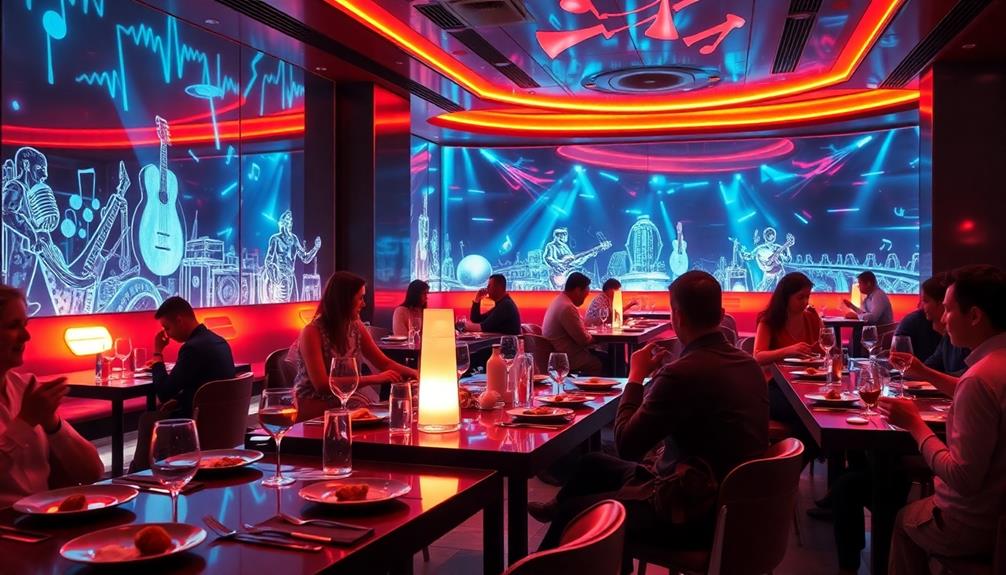
As restaurants evolve, future trends in music are set to enhance your dining experience in exciting ways. You can expect personalized playlists tailored to your preferences, creating emotional connections that elevate your meal. With the integration of AI-driven music selection tools, restaurants will adapt their music in real-time based on customer demographics and mood, improving your overall satisfaction.
Moreover, restaurants will increasingly curate soundtracks that reflect their brand identity. Studies show that congruent music choices can boost revenue by up to 9.1%. Experiential dining will also flourish, featuring live music events that enhance social interaction and create memorable experiences, encouraging you to return.
To better understand these trends, here's a quick overview:
| Trend | Impact |
|---|---|
| Personalized Playlists | Enhances emotional connections |
| AI-Driven Music Selection | Real-time adaptation |
| Brand-Aligned Soundtracks | Increases revenue |
| Live Music Events | Encourages repeat visits |
| Slow-Tempo Music Usage | Improves pacing and satisfaction |
These innovative approaches to using music will transform your dining experience, making it not just a meal, but an unforgettable event.
Frequently Asked Questions
How Does Music Affect Dining?
Music affects your dining experience by shaping your emotions and influencing your food choices. A slower tempo might make you linger, while the right genre can enhance enjoyment and even boost dessert cravings.
How Does Music Affect Experience?
Music shapes your experience by influencing emotions and perceptions. It affects your mood, alters how you taste food, and even changes how long you stay, ultimately enhancing or diminishing your enjoyment of any occasion.
What Is the Relationship Between Music and Food?
Ever thought music's just background noise? It's not! Your dining experience changes with music's tempo and genre, influencing how you perceive flavors and your willingness to indulge. Choose wisely, and enjoy a richer meal!
How Does Music Affect Customer Experience?
Music shapes your experience by influencing your emotions, pace of dining, and perceptions of food quality. It can make you feel relaxed, enhance enjoyment, and even encourage you to try new dishes or linger longer.
Conclusion
As you savor the last bite of your meal, remember how the melodies woven through your dining experience shaped your emotions and perceptions. Just like a maestro conducting an orchestra, the right music can elevate the ambiance, turning an ordinary dinner into a symphony of flavors. With evolving tastes and trends, restaurants will continue to curate soundscapes that not only enhance your meal but also linger in your memory, echoing long after you've left the table.
